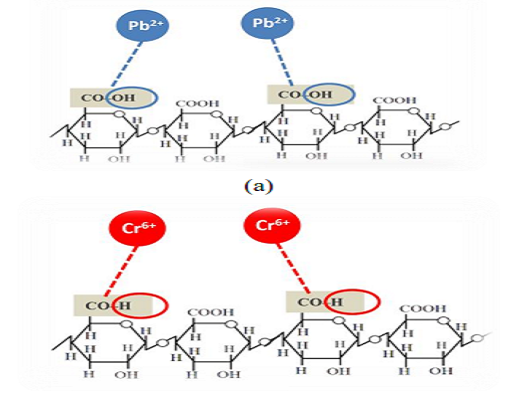Acid and Base modified Pectin from Orange Peel as an Effective Bio-adsorbent for Pb(II) and Cr(VI) from Textile Industry Wastewater
Abstract
Modifying the methoxyl group on pectin from Siam orange peel (Citrus nobilis) has been done. Pectin was obtained from the peel of Siam orange by extraction method. The modified pectin obtained were analyzed using the FT-IR (Fourier Transform-Infra Red Spectroscopy) method, the XRD (X-Ray Diffractometry), and surface appearance images using SEM (Scanning Electron Microscopy). Pb(II) and Cr(VI) metals which can be adsorbed by the adsorbent then analyzed by UV-Visible Spectrophotometer. The results of the FT-IR analysis was found that the modification of the methoxyl group was successful. XRD analysis showed that the modified pectin adsorbent produced amorphous properties. The maximum pH for Pb(II) adsorption was obtained, namely pH = 6 and the maximum pH for Cr(VI) adsorption was pH =7. The best adsorption time variation for Pb(II) was 240 min and for Cr(VI) was 500 min. The best adsorbent for adsorption of Pb(II) was base-modified pectin adsorbent, while the best adsorbent for adsorption of Cr(VI) was base-modified pectin adsorbent. It could be proven that base-modified pectin was able to adsorb Pb(II) and acid-modified pectin was able to absorb Cr(VI) better (Pb(II) 80% adsorption percentage and 90% Cr(VI) adsorption percentage) than previous studies, namely pectin without modification (adsorption percentage obtained 60-70%).
Downloads

Copyright (c) 2023 Nur Lailatul Hanifa, Afifah Afifah, Destia Kusuma Wijaya, Nufus Nurmazaya, Ani Qomariyah

This work is licensed under a Creative Commons Attribution-NonCommercial-NoDerivatives 4.0 International License.
Authors who publish with this journal agree to the following terms:
- Copyright on any article is retained by the author(s).
- The author grants the journal, the right of first publication with the work simultaneously licensed under a Creative Commons Attribution License that allows others to share the work with an acknowledgment of the work’s authorship and initial publication in this journal.
- Authors are able to enter into separate, additional contractual arrangements for the non-exclusive distribution of the journal’s published version of the work (e.g., post it to an institutional repository or publish it in a book), with an acknowledgment of its initial publication in this journal.
- Authors are permitted and encouraged to post their work online (e.g., in institutional repositories or on their website) prior to and during the submission process, as it can lead to productive exchanges, as well as earlier and greater citation of published work.
- The article and any associated published material is distributed under the Creative Commons Attribution-NonCommercial-NoDerivatives 4.0 International License.





_copy1.png)










